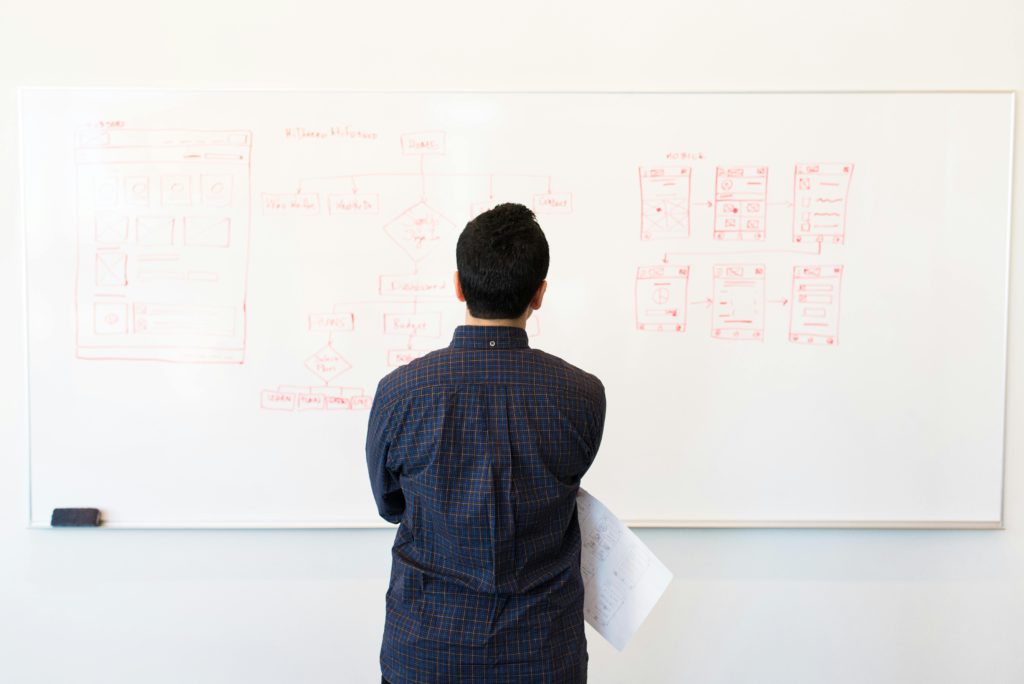After the brief introduction, let’s dig a little deeper into our emotional intelligence. We’ll see the neurological foundation of certain characteristics, how we can analyze our EI capabilities, and talk a bit about how they are developed.
We will be focusing on “Training the brain: cultivating emotional skills”, an informal chat between two leaders in EI research, longtime friends Daniel Goleman and Richie Davidson, where they give us a glimpse of the latest findings in neuroscience (the underlying biological basis for our psychology) related to emotional intelligence.
This conversation revolves around affective and social neuroscience (how emotions operate in the brain and how the brain operates in relationships and during interaction, respectively), and state-of-the-art research Davidson has been leading in his lab.
The key components of Daniel’s model
According to Daniel, our EI can be divided into 3 key components (that matches the 5 more granular categorisations we mentioned earlier):
- Self-awareness: in the brain, the insula is responsible for us being aware of our body. This little region of our brain has a map of the different organs in the body. We become aware of our body when it interacts with our prefrontal cortex. When those two communicate we are able to determine how our body reacts to a particular emotion, for example. We can also be aware of our identity or, in other words, autobiographical memory. The hippocampus is key to this. When it interacts with the prefrontal cortex we become aware of self-related memories. The prefrontal cortex is the area common to all self-awareness processes while also being important for self-regulation.
- Self-regulation: Daniel includes motivation and empathy here.What’s motivation? The ability to hold a goal in mind and to think how we’ll feel when we get there. This ability helps us go through tough situations. To anticipate the positive emotion that we’ll feel as a reward for reaching our goal, the cortex interacts with another area in the brain called the nucleus accumbens, which is responsible for making us feel good when we achieve or get something that we consider rewarding.What’s empathy? First, it’s the ability to perceive what another person is expressing, by interpreting different signals: voice, face, sensory. Basic perception regions of the brain are important at this stage.Then, to experience emotions similar to that of the person we’re perceiving, our sensory areas must interact with the insula. We literally feel along with another person when we empathize with them, in our brain and our body.
- Social interaction: this is where self-awareness and self-regulation come into play to determine how well we can navigate our social surrounding and hopefully get the outcomes we desire.
When compared to other species, our prefrontal cortex is the largest, relative to the size of the brain. That’s why we have a much stronger capacity to manage our emotions. At the same time, we also have the highest capacity to deregulate our emotions. Depression and anxiety occur far more often in humans than in other animals.
How do different people react to emotional challenges?
An emotional challenge could be an argument, or surviving an accident for example. While some can have a car accident and recover the next day, others can be permanently terrified of driving.
I have a fear of heights that resulted from a experience I had a few years ago: I was having fun monkeying around some rock formations on a beach when, at some point, I climbed too far and got stuck. I felt like I was gonna splatter all over the rock formations below. While someone more experienced might have gotten fearful, it would be terrified as I was. My reaction was so strong it left a mark.
There are a few key metrics that define emotional styles of people.
- Rapidity of recovery from a stressful situation: for some people, negative emotions lingers for hours or days, while for others it’s just a transient rise that subsides very quickly.
One of the key components here is the connection between the prefrontal cortex and the amygdala. It’s a really old, in evolutionary terms, part of the brain and it’s mostly associated with fear. It’s responsible for shifting the body state in response to danger, such as increasing the heart rate.
If a person can’t control the amygdala well, when something bad happens or is about to happen, it goes haywire, and might stay like that for longer than needed. - How quickly we respond: do we have a hair trigger and respond very quickly? A phobic reaction is an example. It’s a really strong and fast reaction.
- Intensity of the reaction: the overall amplitude of the response.
- Type of the emotional challenge: people have different reactions to different emotional challenges. Sadness, fear and anger elicit a different reaction in terms stated above.
Using my personal example, my amygdala goes crazy when I’m on any ledge, or even if I see someone in a dangerous spot, making me respond instantly. It’s not really intense because, besides the physical reaction in my feet and the uneasy feeling, I don’t lose control or anything, and taking only a few minutes to recover.
The impact of our childhood on our emotional intelligence
Let’s first introduce the concept of neural plasticity: the extent to which our experiences literally shape the circuitry of our brain.
It was a common belief that our brain was shaped until a certain age, then it slowly declined until death. It turns out recent research has shown quite the opposite. There are many others but I suggest the book “Superbrain” if you want to learn more.
Turns out we can shape our brain throughout our lifetime, and one of the key methods is through meditation. Seems that our brain is built to change in response to experience more than any other organ. That’s why believing that genetics are the most influential factor for our personality is wrong.
The best finding is that the parts of the brain that are responsible for self-awareness, regulation, etc., are the most plastic, or prone to change, given the right stimuli.
The younger brains are more vulnerable to external stimuli and to change, given that it’s in its growing stage, meaning that there’s a bigger risk that toxic environments will have negative effects on a child’s personality and brain. So the way a parent interacts with a child doesn’t just gives them a character and a set of ideals, but it actually shapes their brain and their emotional intelligence.
Direct interaction isn’t the only important aspect though. A lot of learning occurs through observation and imitation. If a child sees their parent react really quickly to a stressful situation, and then be unable to shake it off for a while, it will literally reflect on the circuitry in the child’s brain and on the systems responsible for emotional regulation. On the other hand, if the child can see their parent coping well with something and calming down quickly after a negative emotion, they will build a positive system.
There is evidence that anxiety, or the inability to effectively regulate negative emotion, directly competes with cognitive functions that are also handled in the prefrontal cortex, playing a crucial role in several kinds of learning. In essence, anxiety exhausts the mind, leaving less resources for other activities, such as learning. This matches Simon Sinek’s belief that parents who come home stressed from work are more detrimental to their kids’ wellbeing than their absence.
This tells us that we must be extra careful around children and, more optimistically, that we can mold ourselves through our life and fix or improve our emotional intelligence profile.
Happiness and the Prefrontal Cortex
We previously mentioned Matthieu Ricard as the “happiest person on the planet”.
Research led to an index, that is a ratio of activity in the areas of the right prefrontal cortex, and the left prefrontal cortex. The right one is active when we feel distressed or unhappy, the left being the opposite. So this index is sort of a measure of our happiness!
Tests show the distribution of this index among people follows a bell curve. In other words, most of us are in the middle — we have good days and bad days. People that are far to the right are clinically depressed or anxious. People to the left recover quickly, have low intensity negative emotions and don’t get upset much. On the far left, off the chart, you’ll find Matthieu (he gave a cool talk on TED a while back). He says: “If you can learn how to ride a bike you can learn how to be happy.” Another point in favor of the plasticity of the brain!
Let’s play with plastic
So how do we take advantage of our brain’s malleability? As I mentioned in the previous article, there’s a tool we all have at our disposal to fight negative emotional styles and be more like Matthieu, and that’s meditation!
Analysis of the brain activity of meditation practitioners clearly shows the power meditation has to physically affect our brain.
Meditation should be treated as an exercise. Some exercises develop our leg muscles, others our arm muscles, heart and lungs. The same can be said about meditation. There are different practices and each have different effects on the brain (and consequently the body).
Meditation can be used to voluntarily cultivate compassion. A study was conducted to test this: while meditating, sounds were played, such as a woman screaming in distress, asking for help.
Those that “exercised” their compassion through meditation had an enormously different reaction in the insula (as we mentioned early, that part of the brain that interacts with our body sensors), being more expressive in people that were more veteran practitioners in relation with other less experienced.
This means our capacity for empathy can be directly acted upon by meditation practices with that purpose. And the good news is that the index changes after just 2 months of meditation.
Something else that meditation affects is attention blink. This is important in social interactions, where we miss cues and signs during a conversation all the time. This happens because, once a certain cue is caught, we grasp on to it, then blink through or miss the next one, until we let go of the previous. Meditators are able to notice but not grasp too much of events. This leads to a better empathy, since they’re able to capture more of the nonverbal communication signs in others.
In the next post we’ll cover recommended methods to take control and not let bastards like that little amygdala do as they please.
Cheers,
Looking for your next challenge?






0 Comments